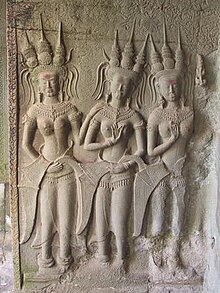| Revision as of 06:26, 17 June 2004 editLordSimonofShropshire (talk | contribs)3,268 editsmNo edit summary← Previous edit | Revision as of 07:16, 18 September 2004 edit undo219.65.124.111 (talk)No edit summaryNext edit → | ||
| Line 1: | Line 1: | ||
| ] | ] | ||
| Apsaras, the celestial entertainers of Indra's court are said to be able to change their shapes at will. Urvasi, Meneka, Rambha and Tilottama are the most famous among Apsaras who are well versed in the art of music and dancing. | |||
| ⚫ | In ], the '''Apsaras''' (also '''Vrikshakas''') are nature spirits, |
||
| ⚫ | In ], the '''Apsaras''' (also '''Vrikshakas''') are sometimes referred to as nature spirits, the wives of the ]'s, court servants of Indra. They ]d to the ] made by their husbands, usually in the various gods' palaces. In India, it is popularly believed that some of the outstanding ] and ] dancers, such as Medha Hari, are the incarnations of apsaras. | ||
| The Apsara was associated with fertility rites. | The Apsara was associated with fertility rites. | ||
Revision as of 07:16, 18 September 2004

Apsaras, the celestial entertainers of Indra's court are said to be able to change their shapes at will. Urvasi, Meneka, Rambha and Tilottama are the most famous among Apsaras who are well versed in the art of music and dancing.
In Hinduism, the Apsaras (also Vrikshakas) are sometimes referred to as nature spirits, the wives of the Gandharva's, court servants of Indra. They danced to the music made by their husbands, usually in the various gods' palaces. In India, it is popularly believed that some of the outstanding Odissi and Bharata Natyam dancers, such as Medha Hari, are the incarnations of apsaras.
The Apsara was associated with fertility rites.
The Apsara were very beautiful and sometimes lured men to their deaths.
Apsaras are often depicted in Buddhist art as far afield as Cambodia and China, however.

This article is a stub. You can help Misplaced Pages by expanding it. |
